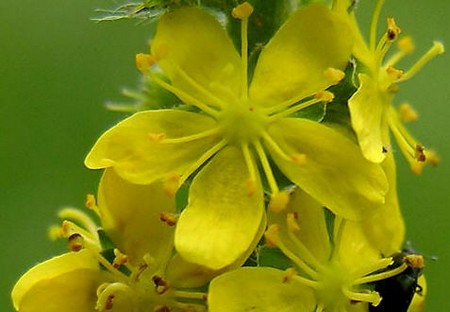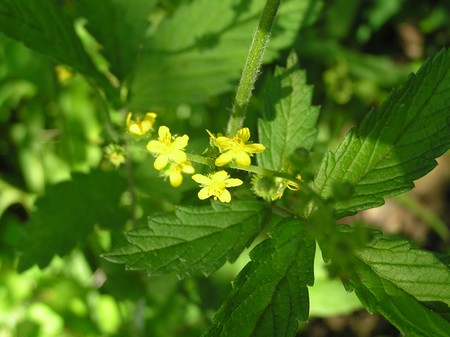Found in summer hedgerows, fields and waste ground, agrimony is easily recognized by its delicate long spike of yellow flowers smelling of apricots, and its beautifully shaped leaves. Its country name, church steeples, refers to its rising spire of yellow flowers, while names such as cockleburr and stickle-wort refer to the seed which attaches itself to passers-by, both animal and human.
Agrimony was praised by the Ancient Greeks and Romans for its healing properties. The name agrimony comes from the Greek argemone, a white speck in the eye, because of its ability to heal the eyes; the Greeks apparently used it for cataracts. Eupatoria is derived from Mithridates IV Eupator, King of Pontus 120-63BC, a skilled herbalist who was the first to employ agrimony for liver complaints and also to counteract poisons.
In Anglo-Saxon times agrimonv was used to heal wounds and treat snakebites and was one of the 57 herbs in the Anglo-Saxon Holy Salve believed to protect one from goblins, evil and poison. Chaucer refers to its use for ‘alle wounds’ and medieval monks grew agrimony in their monastery gardens as a cure for stomach aches and open wounds. Culpeper recommended it to be taken internally and applied externally for gout, as well as for bruises, sprains, wounds and snakebites. Gerard said it was ‘good for naughty livers’. In North America agrimony was a fever remedy for native Americans and Canadians and it has been likened to Peruvian bark for its ability to relieve fever and malaria. The French drink agrimony tisanes and use on sprains and bruises in their famous eau de arqmbusade, made originally for battle wounds in the 15th century. In the language of flowers agrimony symbolizes gratitude.
Herbal remedy
Today, agrimony is still important as a digestive tonic and an astringent. The tannins act to tone the mucous membranes of the gut, improving their secretion and absorption while protecting against irritation and infection. It helps to prevent and to remedy peptic ulcers and colitis and makes a good remedy for diarrhoea. The bitters stimulate the secretion of digestive juices and bile from the liver and gall-bladder, enhancing digestion and absorption as well as bowel function. In Germany agrimony has been used to treat gallstones and cirrhosis of the liver. It is also a good remedy for gout and arthritis, as it acts as a diuretic, clearing excess uric acid.
You can also use agrimony as an excellent astringent for heavy periods, and externally for stemming bleeding and speeding healing of cuts and wounds. As a gargle or mouthwash you can use it for sore throats and inflamed gums. It makes a good eyewash for inflammatory eye problems and a douche for vaginal discharges and infections.
Homeopathic remedy: Agrimonia
Agrimonia is also used for menstrual and digestive problems. It helps to clear catarrh throughout the digestive, respiratory, and genito-urinary systems.
The flower essence
Agrimony is particularly for those who appear carefree and cheerful; they are popular and have a good sense of humour. However, their brave face masks inner torture or turbulence which they are careful not to inflict on others. They are concerned to keep peace and harmony, so do not like to upset other people and are distressed by tension and conflict. They will go out of their way to avoid confrontation and to keep other people happy. When ill they make light of their symptoms. Generally they hate to sit still or to be alone, for fear their suppressed emotions may come to the fore and they may have to face their darker side or their problems. Agrimony people keep their rose-tinted spectacles firmly on. Such people may indulge in alcohol, drugs or a wide range of exciting activities to distract them from their inner selves.
Agrimony helps such people to acknowledge the real, sometimes darker side of themselves or others. It engenders inner strength to face the problems of everyday life and from the past. In this sense, agrimonv is a remedy for perception. The Greeks used it as a remedy to heal the eyes. As a flower remedy it helps one to see things as they truly are.

